
Is Honduras actually dangerous? [2024]
Honduras often finds itself in the spotlight for being a dangerous country, full of drug trafficking, gangs, and murders. However, beneath the surface lies a country rich in history, culture, and natural beauty. In this blog post, we delve into the question: Is Honduras actually dangerous?
We’ll touch on why travellers should want to visit Honduras and a bit about the history of the country and what contributes to its bad reputation. We’ll share our experience of travelling in this amazing country and give loads of tips for travellers looking to visit Honduras.
So, is Honduras actually dangerous? Let’s find out!
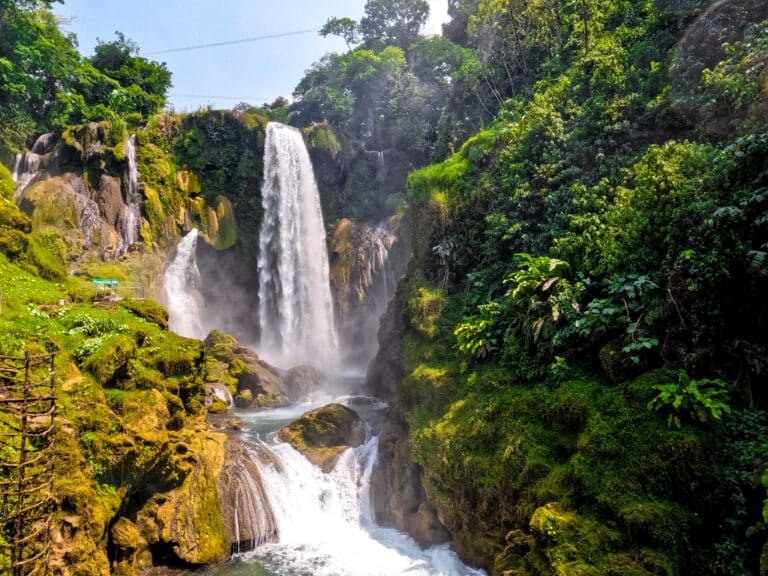
Pulhapanzak Waterfall in Central Honduras
WHY VISIT HONDURAS?
Honduras is a country with a big heart. It is without a doubt worth a visit.
With 470 miles of Caribbean coastline, Honduras is home to a stretch of the world’s second largest barrier reef. There are some beautiful beaches, tropical islands, and a sparkling turquoise ocean to dive into. And talking about diving, Honduras has so much going on underwater: divers can’t get enough of the Bay Islands. And, if you’re looking to get PADI certified, Honduras is one of the cheapest places in the world to get your diving certification!
Head inland, and you’ll discover the second-largest rainforest in the Americas. Honduras has enough biodiversity to rival Costa Rica, with over 770 species of birds alone. Add to that a whole host of Mayan ruins, amazing locally-grown coffee, low-cost activities, and genuinely kind local people, and you’ve got yourself what seems like a dream destination!
Travelling north from Panama, we listened eagerly to anyone travelling south who could tell us about Honduras and El Salvador. Not on many itineraries, there are two popular Honduran destinations: the Bay Islands, popular for diving, and the Mayan Ruins of Copan Ruinas. But what about the rest of Honduras? From the large Lake Yojoa to the Pulhapanzak Waterfalls, there’s so much more to explore!
Many tourists skip over Honduras and El Salvador. Some cautious travellers even skip Guatemala and Nicaragua, hopping from Mexico to Costa Rica due to safety concerns (we think that’s silly, Nicaragua and Guatemala have so much going on!)
But is Honduras actually dangerous?
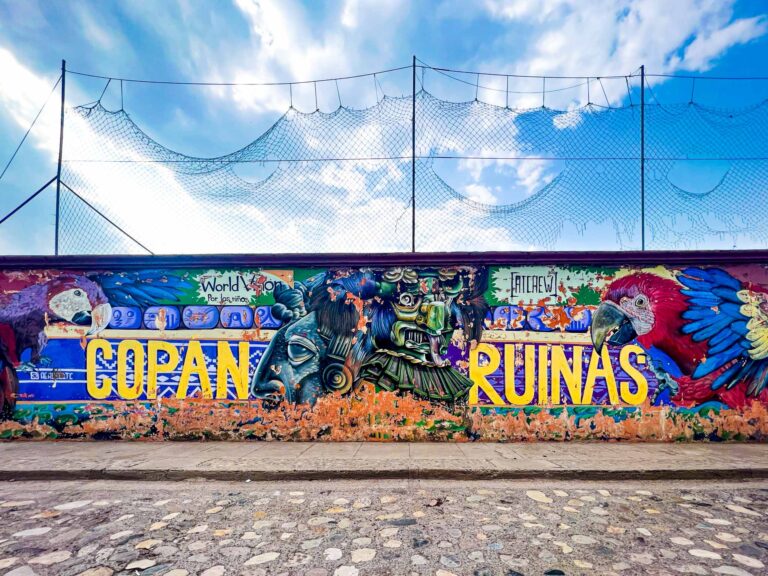
Street Art in the town of Copan Ruinas
SO WHAT’S THE PROBLEM…?
Well, Honduras might sound like paradise, but it’s definitely not the safest country out there…
To put it quite frankly, Honduras has a bad reputation. This Central American country is known for having one of the highest murder rates in the world. Although this is going down, as of 2022 Honduras was still up there in the top five countries for homicides. Being dangerous is what Honduras is known for internationally.
This is why we’re here to answer the question: is Honduras actually dangerous?
WHY IS HONDURAS SEEN AS A DANGEROUS COUNTRY?
Honduras boasts a diverse history shaped by indigenous civilizations, Spanish colonisation, and the tumultuous struggles for independence and democracy. The country’s cultural heritage is evident in its archaeological Mayan sites, colonial architecture, and vibrant traditions.
But despite this rich history, for years Honduras has grappled with the same challenges that many Central American countries have faced.
This Central American ‘corridor’ between South America and the USA leads to a lot of gang activity and drug trafficking. There are two main gangs: Mara Salvatrucha (MS-13) and Barrio 18. These drug trafficking gangs rule people’s lives. They practice “war taxing”, demanding money from local people, which keeps everyone in poverty. And political instability means that corrupt governments often turn a blind eye.
But what people don’t focus on is that the situation is improving. Honduras had the fifth largest improvement in peacefulness on the 2020 Global Peace Index (GPI). The level of conflict has declined by 52% over the last five years (according to the Honduran government). Negotiations with criminal groups, and economic aid from the USA, is helping Honduras lower its crime rate. Slowly but surely, it’s getting safer.
And whilst Honduras is definitely not the safest country in Central America, the government promotes tourism. And people still go.
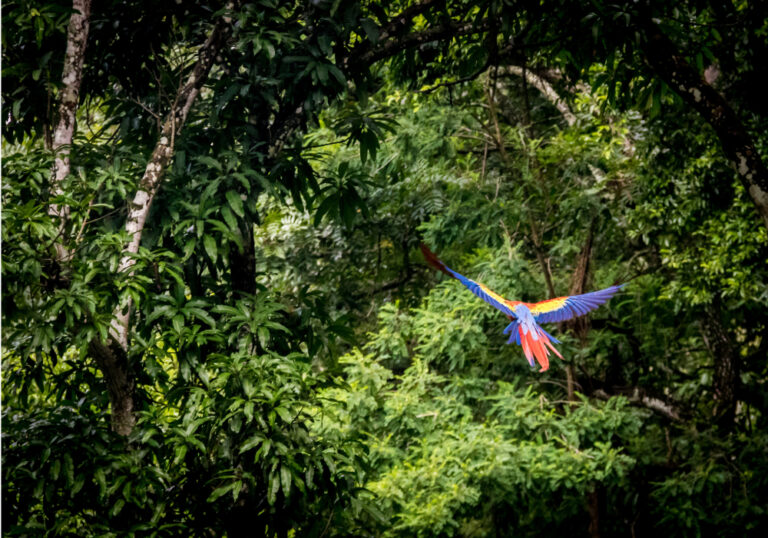
Honduras has amazing biodiversity!
IS HONDURAS ACTUALLY DANGEROUS: THE SITUATION TODAY
Tourism in Central America is taking off and Honduras wants in!
The government is keen to address the country’s issues and reap the economic and developmental benefits of tourism seen in nearby countries such as Panama and Costa Rica. Promotion and increased police presence in tourist areas, such as the Mayan ruins of Copan and the Bay Islands, have led to a pockets of Honduras with a decline in crime rates and uptick in tourism.
But is Honduras actually dangerous? Well, yes and no.
It’s important to recognise that some places are more dangerous than others. The Bay Islands of Utila and Roatan are inherently safer than the mainland. And the small town of Copan, with its famous Mayan ruins, is safer than the larger cities of San Pedro Sula and Tegucigalpa. Many visitors and residents travel to and around Honduras every year without major issues.
Across the country, significant challenges remain, including entrenched inequality, institutional weaknesses, and ongoing threats from organised crime. Poverty is still a problem. And large cities are still not the safest places to be, even in the daylight.
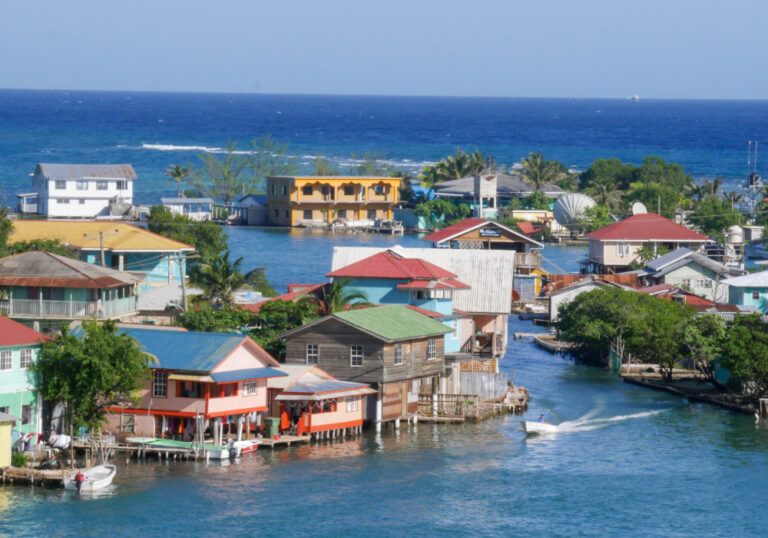
Honduras’ Bay Islands
THE SAFEST PLACES IN HONDURAS:
We’ve touched on some places in Honduras being more sketchy than others. But luckily, the safest places in Honduras are the ones you probably want to visit as a tourist. And the unsafe places probably aren’t worth visiting anyway…
Hondurans are very keen to have visitors, and really want you to like their country. If you can speak Spanish, that’s a huge plus. It will help you navigate tricky situations and lower your chances of being taken advantage of.
#1 THE BAY ISLANDS
The Bay Islands of Honduras (Utila and Roatan) can be considered mostly safe. The larger island of Roatan is very developed, with bougie resorts set against white sandy beaches. Roatan attracts a lot of families, cruise ship tourists, and wealthy older travellers. The diving is amazing, but it’s expensive to stay there.
The polar opposite, Utila is a backpacker and diver’s paradise, and it’s unlike the rest of mainland Honduras in just about every way. There are dive shops, backpacker hostels, a microbrewery, and charming but ramshackle bars and restaurants. Golf carts are the main vehicle here and the island is all-round good vibes.
Both Roatan and Utila are very safe compared to mainland Honduras. We would walk around to the bars and restaurants at night, usually as a pair or in a group with hostel friends. I never felt unsafe here at all!
#2 COPAN RUINAS
Copán Ruinas is small town in western Honduras, just 10km away from the border with Guatemala. With cobblestone streets, colorful buildings, and the famous Mayan ruins of the same name, Copán Ruinas is one of the safest places in Honduras to visit.
Copán attracts a lot of day-trip tourists from Guatemala. The ruins are some of the most famous in Central America, and well worth a visit. The town is a safe, chill place to walk around and hang out. Zero bad vibes here, even after dark.
#3 LAGO YOJOA
Lago Yojoa is Honduras’ largest natural lake. With quaint villages, coffee plantations, and nature reserves, there are endless opportunities for hiking, birdwatching, and eco-tourism adventures. The lake and the surrounding villages are safe and friendly places. There’s even a micro-brewery hostel!
Lago Yojoa is less touristy than other places in Honduras. We felt very safe during the day taking collectivos and public buses to explore the area. In the evening, we mostly hung out at D&D Hostel around the campfire.
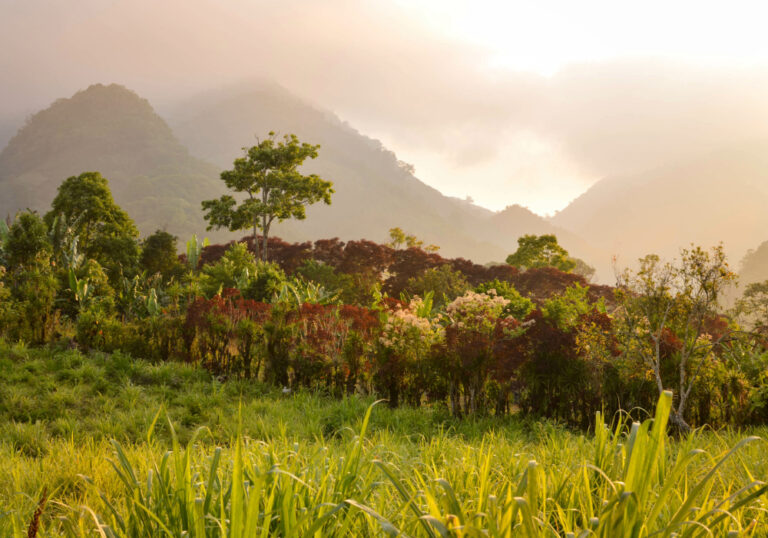
Rural Honduras
PLACES TO AVOID IN HONDURAS
#1 TEGUCIGALPA
The capital city of Honduras, Tegucigalpa, is known for high gang activity. Like most Central American cities, Tegucigalpa is big, dirty, and wholly uninteresting. There’s honestly not that much to see and do anyway.
If you need to visit Tegucigalpa, exercise a lot of caution. Stay away from the small alleys and side streets. Stick to the tourist spots and areas where there are a lot of people. Completely avoid going out at night. If you have to change buses here, stay inside a café or restaurant until your bus arrives. Bus stations can attract some pretty sketchy characters!
#2 SAN PEDRO SULA
Another large city with a lot of gang activity and not a lot worth looking at. The high poverty here causes a need for petty crime, so keep an eye on all your belongings! There’s not much to do here for tourists either. Perhaps consider leaving it out of your Honduras itinerary completely.
If you’re travelling from the Bay Islands inland to Lago Yojoa or Copan Ruinas, you might need to change buses here. The main bus terminal is a bright, shiny and modern shopping mall and has armed security guards, so it’s pretty secure. That said, we recommend always leaving enough daylight to get to your destination, no matter where in Central America you travel.

Parrots in the Mayan Ruins!
IS HONDURAS ACTUALLY DANGEROUS: OUR EXPERIENCE
I would have liked to have spent longer exploring Honduras, but due to time constraints, we only had time to visit the Bay Islands, Lake Yojoa, and Copan. We took a private minibus from Nicaragua to the Bay Islands, and public transport across Honduras towards El Salvador, changing buses in San Pedro Sula.
While we were in Honduras we did not encounter one single problem. In fact, there wasn’t a single moment where I felt unsafe. That’s more than I can say for Honduras’ more popular neighbour, Guatemala, which was the only country I felt unsafe as a traveller in Central America. Guatemala was sketchy in places.
During our visit to Honduras, I was struck by the warmth of its people. The locals are so kind and excited to interact with you. They want you to like their country, despite its rocky history, and love to have a chat, especially if they get to bitch about the government! Unlike neighbouring countries (hello again, Guatemala), you don’t feel like you’re walking around with a big flashing dollar sign over your head. Hondurans want to get to know you, they mostly don’t care about making money from you.
If you follow the tips below and exercise common sense, respect locals, mind your own business, you should have a safe and enjoyable trip to Honduras.
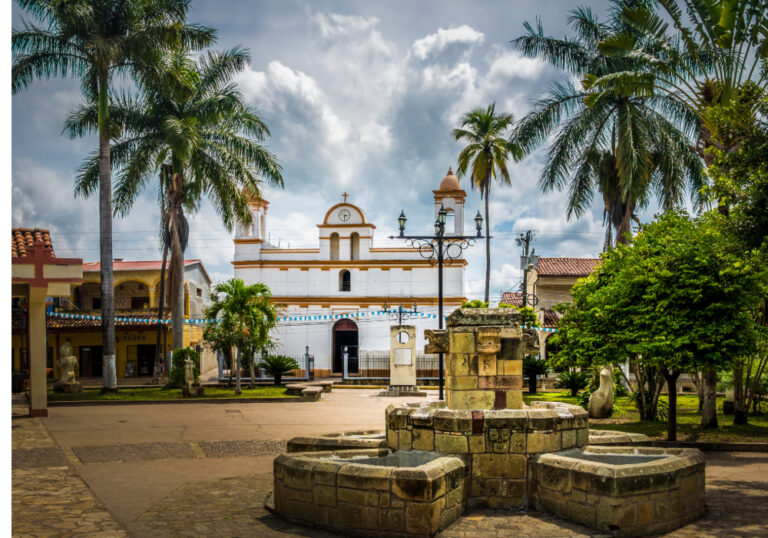
Around town in Copan Ruinas
10 TIPS TO STAY SAFE IN HONDURAS
Although you’re unlikely to be affected by gang violence as a tourist, Honduras is the type of place where you can still find yourself in a bad situation easily. Things can escalate very quickly. Stick to the safer places, exercise common sense, and follow our tips below.
1. Don’t carry valuables. Carry nothing when you walk through a city especially. If you are a tourist carrying a backpack, you’re essentially walking around with a big sign on your back screaming ‘Look at me, I just arrived, I don’t know what I’m doing, and I have all my things with me’. If you travel with possessions in the city, you take a cab, with a driver booked through a trusted source.
2. Don’t even look wealthy. Jewellery, designer clothes, taking your brand new shiny iPhone out in a dodgy bus station, filming that vlog with your DLSR… We’re not victim-blaming, but it’s an advert for thieves. I didn’t take my smartwatch to Central America, and although I missed wearing it, it was too flashy for me to feel comfortable wearing.
3. Definitely, don’t resist a robbery. If you’re unlucky enough to get robbed just hand it over. Your iPhone, camera, passport… it’s not worth your life! Better yet…
4. … carry decoy valuables. If you do have to walk around with your stuff, have a decoy ready to hand over in case you do get robbed. We carried our valuables in hidden waist belts throughout Central America. However, we had old smartphones with Google Maps for getting around and thrifted a wallet with some old bank cards and enough cash to be believable (in USD and local currency).
5. Be vigilant in busy places. Crowds are a pickpocket’s paradise.
6. Don’t do drugs. Seriously, don’t get involved. They’re illegal, and you don’t want to get on the wrong side of a gang. Or support the drug trafficking industry.
7. Avoid travelling alone. Buddy up with some hostel buddies if you’re walking around or taking public transport. You’ll make yourself less of a target. Bonus points if you find someone with fluent Spanish!
8. Don’t hitchhike or accept lifts from strangers. There are places in the world to do this relatively safely. Honduras is not one of them.
9. Follow the locals. Ask locals about what areas they think are safe and where to avoid. Or simply get recommendations for things to eat, drink, see or do. Hondurans are super friendly and genuinely interested in travellers.
10. Learn some Spanish. You’ll have a much easier time, we can guarantee it!
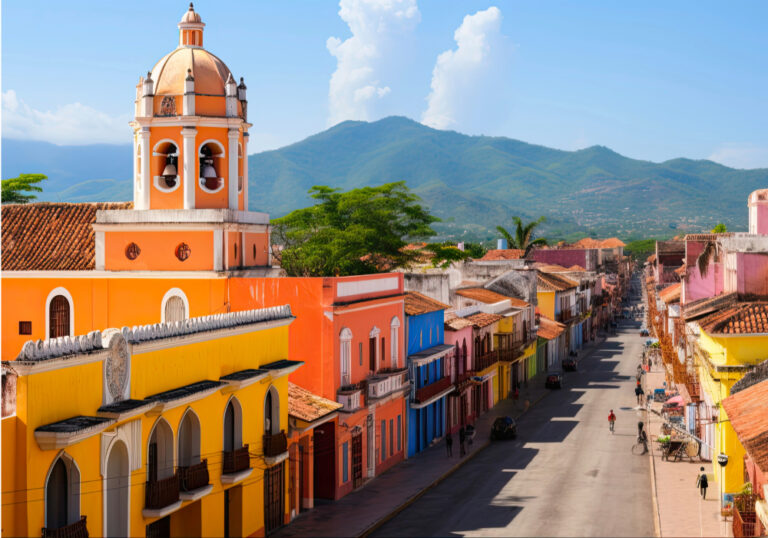
Comayagua, a small town in Honduras
DISCLAIMER:
No travel can be guaranteed safe. And there is no such thing as a perfect safety guide! The question of “Is Honduras actually dangerous?” will always have a different answer – it depends on who’s asking! This article is our view on whether Honduras is a safe country to travel in. It’s based on our experiences and isn’t guaranteed to be completely up-to-date for the most current events.
The information here was accurate at the time of writing but the world is a changeable place! Always do your own research. UK-based readers may wish to start with the UK Government page for travel in Honduras for up-to-date advice and news. USA-based readers can find the same from the Department of State here. Travel advisory websites can be a bit overzealous, if you listen to them completely you’d never leave your home! But they’re a good way to start your travel planning.
As in any country, if you do your research, exercise common sense, and don’t do anything you wouldn’t do at home, the chances of something bad happening are slim!
If my content helped you plan your next adventure, taught you something new, or simply made you smile, consider supporting the site! A small donation helps keep this blog going, fuels my creativity, and maybe even buys me a coffee along the way. Thank you for being here and being part of this journey! 😊
FAQs
IS UBER SAFE IN HONDURAS?
There is no Uber in Honduras. Instead, there are thousands of individually-owned taxis…
SO, ARE TAXIS SAFE IN HONDURAS?
Taxis are everywhere in Honduras, and they’re generally safe.
As with any country, radio taxis are always a better option than hailing one off the street. Your accommodation should be able to recommend or book one for you.
Agree on a price before you get into the taxi, and make sure that you tell the taxi driver that you don’t want to share the taxi. If you don’t speak Spanish, it’s “No quiero compartir el taxi”
ARE BUSES SAFE IN HONDURAS?
Public transportation in Honduras is confusing and not always safe.
The public buses are the same chicken buses that you’ll be familiar with from the rest of Central America. These old USA school buses are poorly maintained and extremely overcrowded. The biggest risk when taking a chicken bus in any country is simply, road accidents. Buses are sometimes “taxed” by gangs or the drivers are assaulted but this is less common.
But travelers do take these buses. We took these buses. And we felt safer on the chicken buses and collectivos in Honduras than we did in Guatemala!
There are also private coach services that connect cities and towns in Honduras. These are usually more maintained, more comfortable, and more expensive. You pay for safety, but better safe than sorry!
IS THE WATER SAFE IN HONDURAS?
Nope! We don’t recommend drinking the water in Honduras.
Lots of travellers stick to bottled water, but single-use plastic is terrible for the planet. We always travel with our water to go travel filter bottles. You can read our review of them here. If you fancy buying one (we’d recommend it!), we can offer you a little discount. We don’t run ads on Discoveny and this is a great way you can support us, without it costing you anything.
LIKE IT? PIN IT!
SAVE THIS POST TO YOUR PINTEREST BOARD TO COME BACK LATER
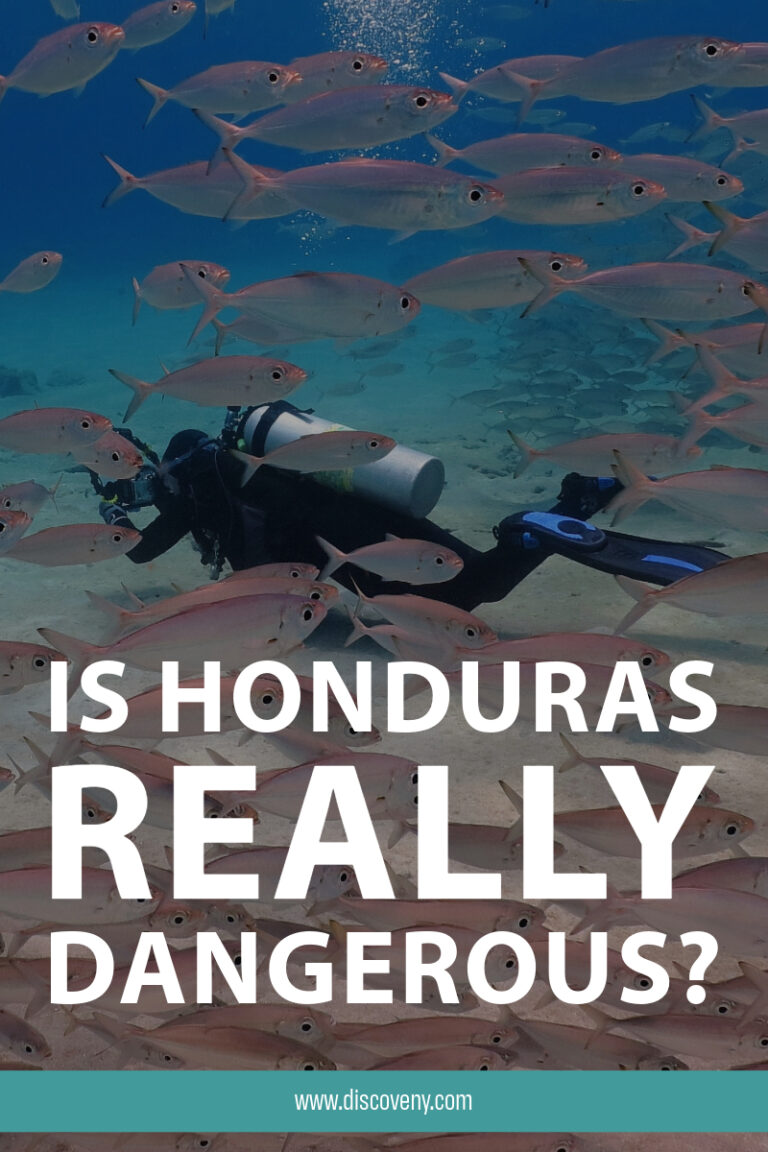
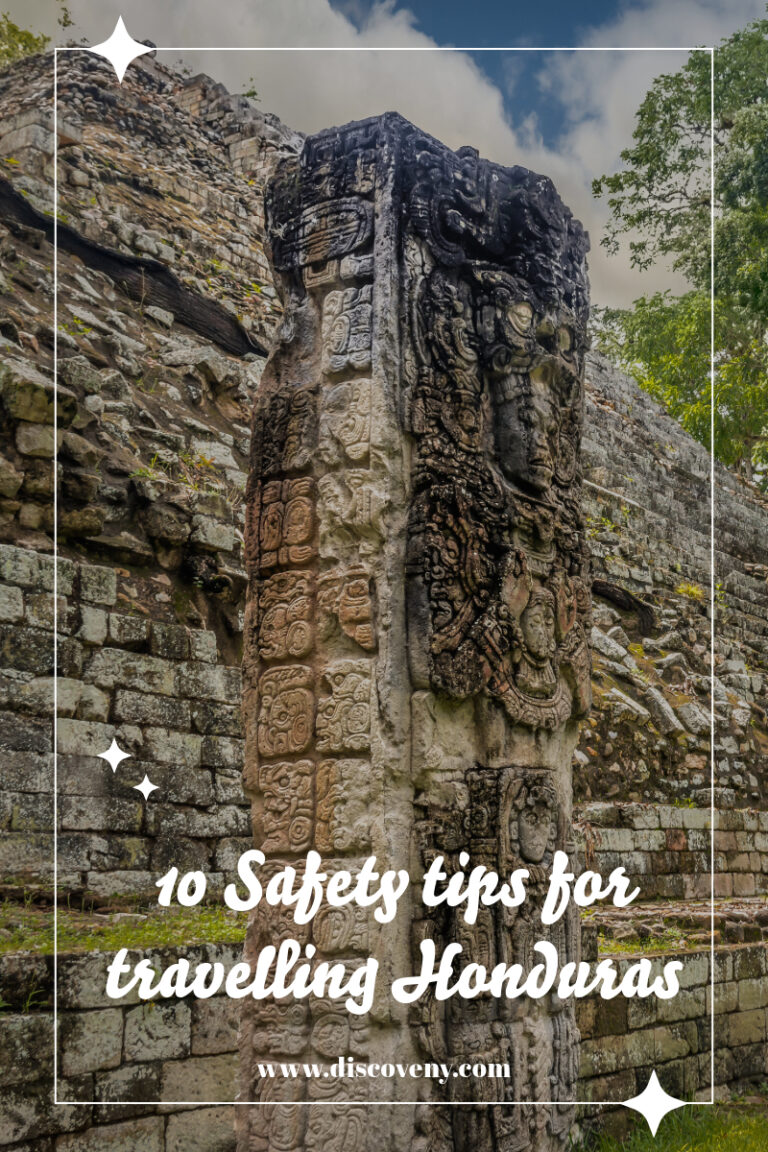
Follow our daily adventures on Facebook and Instagram
Disclaimer: The information and advice provided in this blog are the author’s opinions and based on their personal experiences. All information was accurate at the time of writing. However, things can change quickly, so always double-check current conditions and guidelines before setting out. Remember, your travels and safety are your own responsibility, and this blog can not be held responsible for anything that might happen on your adventures! Always exercise caution and good judgment. Oh, and don’t forget to get travel insurance! Happy travels!
This post may contain affiliate links (yay for transparency!) This means that I will earn a small commission, at no additional cost to you, if you click the link and choose to buy the product. I only link to stuff I have personally bought and found useful and never endorse crap. Your support helps keep the site going, thank you!
Alice
Alice is a UK travel blogger who advocates sustainable travel and being more eco-conscious on a budget. She loves coffee, her houseplants and summiting mountains.
You May Also Like

Backpacking in your mid-twenties: 6 reasons why Central America is the PERFECT destination.
November 11, 2023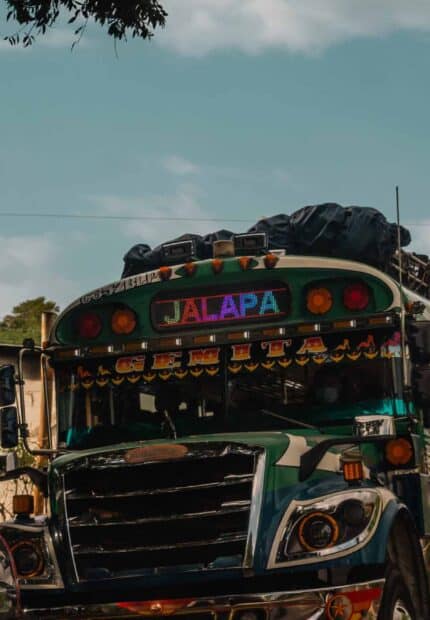
Chicken Buses in Central America: The Ultimate Guide
October 1, 2023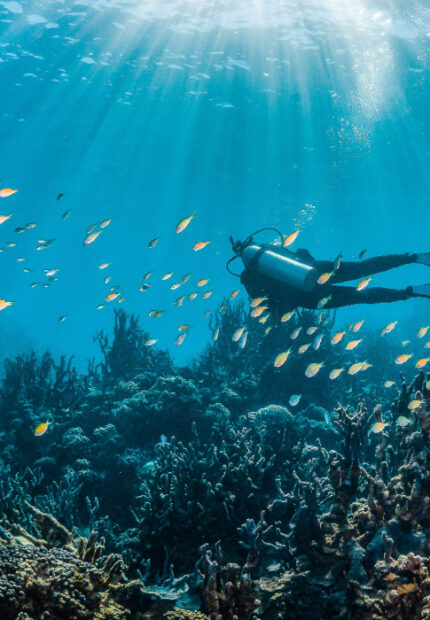

2 Comments
Brandon Hill
Hey Alice! I just wanted to share real that it seems your article is based on what you’ve heard and not what you’ve lived. San Pedro Sula is an awesome city! Of course, like any other city in the world, there are bad spots and good spots. I lived in San Pedro Sula for a few months and there’s plenty of cool things to do out there. There’s quite a few craft beer places like La Jungla, Angeli Gardens. There’s places to take hikes, there’s Uber, and lots of cool restaurants. I found it to be like any other normal city and there’s even a place I like to call Little America because of it’s resemblance to bigger cities.
Tegucigalpa is also a city with good spots and bad spots like any other place in the world. I had lots of fun out there and went out at night with my wife and a local friend to this Spanish restaurant; it was quite delightful. Around Tegucigalpa you’ve got “magical towns” like Valle de Angeles or Santa Lucia. These places offer an amazing atmosphere, even more amazing coffee and hot chocolate, hiking, and nice clean fresh air. Tegucigalpa is surrounded by mountainous pine trees which is a HUGE contrast compared to the tropical rainforest climate of the northern part of the country.
In conclusion, Honduras is most definitely underrated and I’ve traveled to other countries and even had my scooter jacked amongst other things. I almost got shot in the US once, got in a bad metro fight in Madrid, and had people spit at me in Italy (of course these are some of my most unpleasant experiences). Life is about living and getting to live cultures and cities regardless of what people tell you. Give these places a shot! You won’t regret it.
Alice
Agree – crime can happen anywhere, regardless of how ‘dangerous’ a country is perceived to be. Thank you for sharing your awesome recommendations for Tegucigalpa and SPS. Honduras is totally underrated and I had an incredible time there. I’d love to come back in the future and visit even more of this beautiful country, with improved Spanish skills next time for an even more in-depth experience